Jocelyn Chanussot
Thoth
Hyperspectral Imaging
Aug 11, 2025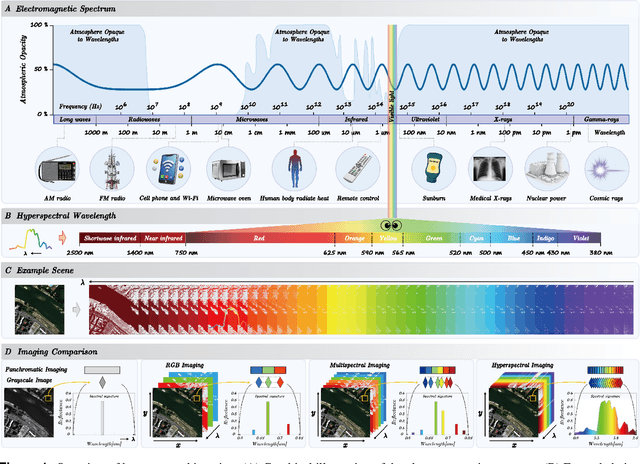

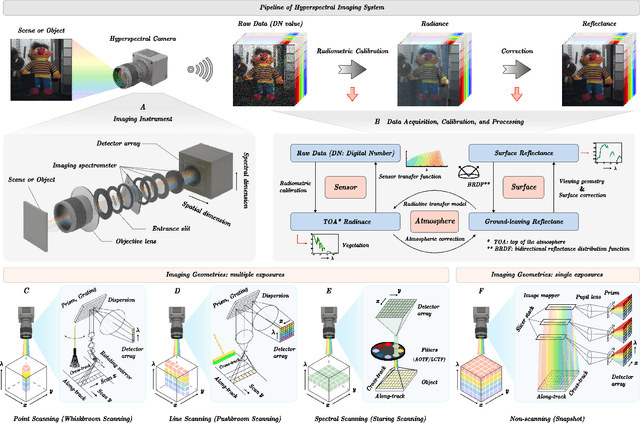

Abstract:Hyperspectral imaging (HSI) is an advanced sensing modality that simultaneously captures spatial and spectral information, enabling non-invasive, label-free analysis of material, chemical, and biological properties. This Primer presents a comprehensive overview of HSI, from the underlying physical principles and sensor architectures to key steps in data acquisition, calibration, and correction. We summarize common data structures and highlight classical and modern analysis methods, including dimensionality reduction, classification, spectral unmixing, and AI-driven techniques such as deep learning. Representative applications across Earth observation, precision agriculture, biomedicine, industrial inspection, cultural heritage, and security are also discussed, emphasizing HSI's ability to uncover sub-visual features for advanced monitoring, diagnostics, and decision-making. Persistent challenges, such as hardware trade-offs, acquisition variability, and the complexity of high-dimensional data, are examined alongside emerging solutions, including computational imaging, physics-informed modeling, cross-modal fusion, and self-supervised learning. Best practices for dataset sharing, reproducibility, and metadata documentation are further highlighted to support transparency and reuse. Looking ahead, we explore future directions toward scalable, real-time, and embedded HSI systems, driven by sensor miniaturization, self-supervised learning, and foundation models. As HSI evolves into a general-purpose, cross-disciplinary platform, it holds promise for transformative applications in science, technology, and society.
Prospects for Mitigating Spectral Variability in Tropical Species Classification Using Self-Supervised Learning
Mar 17, 2025Abstract:Airborne hyperspectral imaging is a promising method for identifying tropical species, but spectral variability between acquisitions hinders consistent results. This paper proposes using Self-Supervised Learning (SSL) to encode spectral features that are robust to abiotic variability and relevant for species identification. By employing the state-of-the-art Barlow-Twins approach on repeated spectral acquisitions, we demonstrate the ability to develop stable features. For the classification of 40 tropical species, experiments show that these features can outperform typical reflectance products in terms of robustness to spectral variability by 10 points of accuracy across dates.
* 5 pages, 3 figures, published as proceeding of the "2024 14th Workshop on Hyperspectral Imaging and Signal Processing: Evolution in Remote Sensing (WHISPERS)"
UrbanSAM: Learning Invariance-Inspired Adapters for Segment Anything Models in Urban Construction
Feb 21, 2025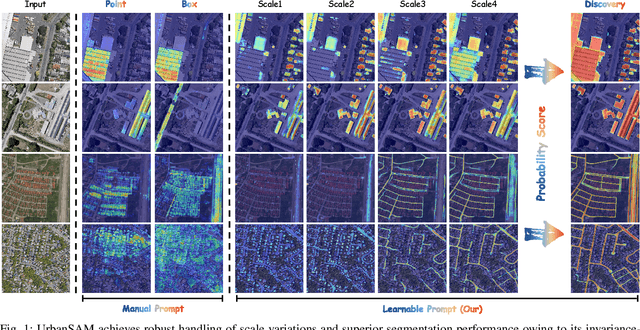

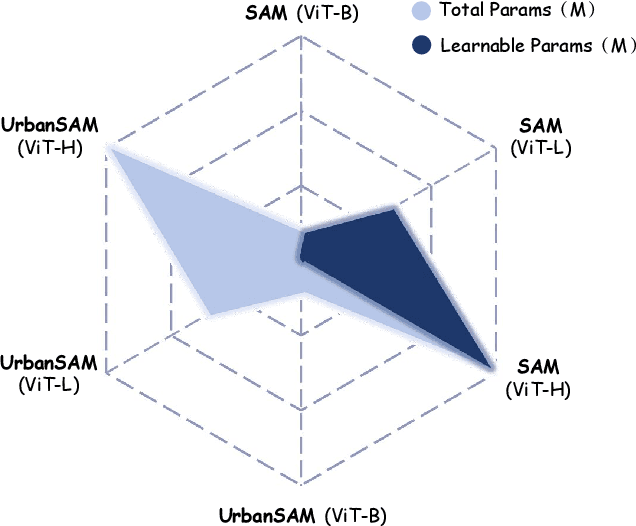
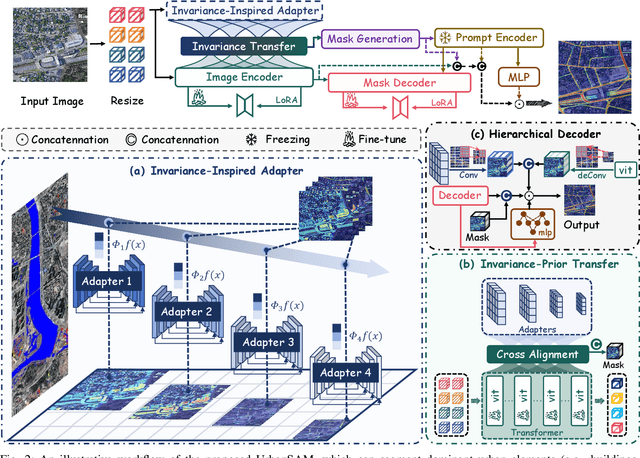
Abstract:Object extraction and segmentation from remote sensing (RS) images is a critical yet challenging task in urban environment monitoring. Urban morphology is inherently complex, with irregular objects of diverse shapes and varying scales. These challenges are amplified by heterogeneity and scale disparities across RS data sources, including sensors, platforms, and modalities, making accurate object segmentation particularly demanding. While the Segment Anything Model (SAM) has shown significant potential in segmenting complex scenes, its performance in handling form-varying objects remains limited due to manual-interactive prompting. To this end, we propose UrbanSAM, a customized version of SAM specifically designed to analyze complex urban environments while tackling scaling effects from remotely sensed observations. Inspired by multi-resolution analysis (MRA) theory, UrbanSAM incorporates a novel learnable prompter equipped with a Uscaling-Adapter that adheres to the invariance criterion, enabling the model to capture multiscale contextual information of objects and adapt to arbitrary scale variations with theoretical guarantees. Furthermore, features from the Uscaling-Adapter and the trunk encoder are aligned through a masked cross-attention operation, allowing the trunk encoder to inherit the adapter's multiscale aggregation capability. This synergy enhances the segmentation performance, resulting in more powerful and accurate outputs, supported by the learned adapter. Extensive experimental results demonstrate the flexibility and superior segmentation performance of the proposed UrbanSAM on a global-scale dataset, encompassing scale-varying urban objects such as buildings, roads, and water.
A Survey of Sample-Efficient Deep Learning for Change Detection in Remote Sensing: Tasks, Strategies, and Challenges
Feb 05, 2025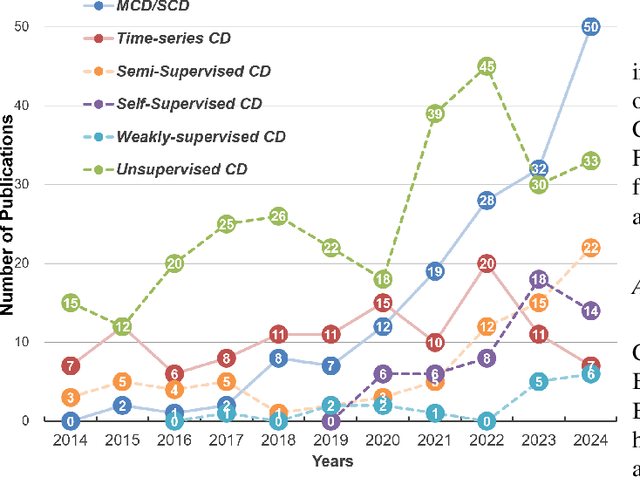
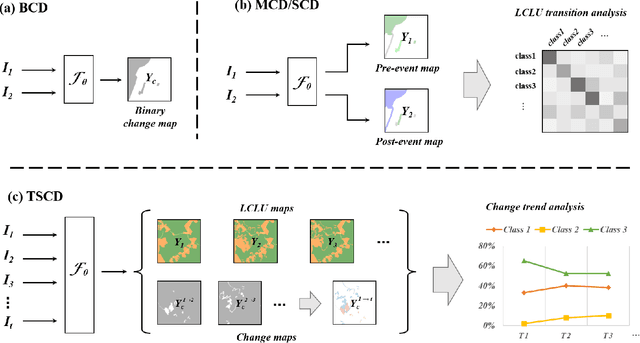
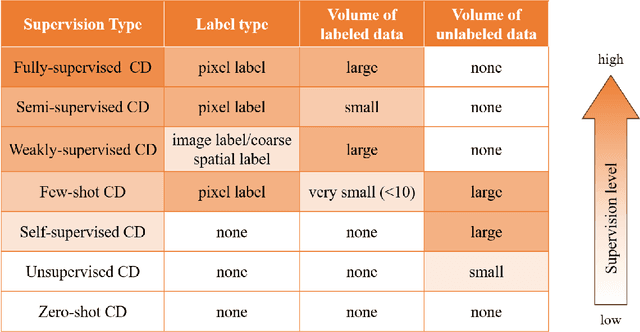
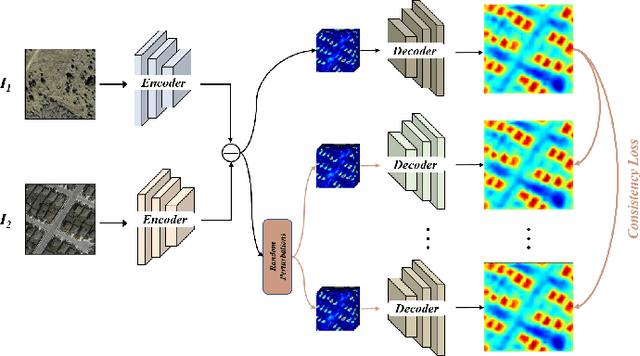
Abstract:In the last decade, the rapid development of deep learning (DL) has made it possible to perform automatic, accurate, and robust Change Detection (CD) on large volumes of Remote Sensing Images (RSIs). However, despite advances in CD methods, their practical application in real-world contexts remains limited due to the diverse input data and the applicational context. For example, the collected RSIs can be time-series observations, and more informative results are required to indicate the time of change or the specific change category. Moreover, training a Deep Neural Network (DNN) requires a massive amount of training samples, whereas in many cases these samples are difficult to collect. To address these challenges, various specific CD methods have been developed considering different application scenarios and training resources. Additionally, recent advancements in image generation, self-supervision, and visual foundation models (VFMs) have opened up new approaches to address the 'data-hungry' issue of DL-based CD. The development of these methods in broader application scenarios requires further investigation and discussion. Therefore, this article summarizes the literature methods for different CD tasks and the available strategies and techniques to train and deploy DL-based CD methods in sample-limited scenarios. We expect that this survey can provide new insights and inspiration for researchers in this field to develop more effective CD methods that can be applied in a wider range of contexts.
SeaMo: A Multi-Seasonal and Multimodal Remote Sensing Foundation Model
Dec 26, 2024



Abstract:Remote Sensing (RS) data contains a wealth of multi-dimensional information crucial for Earth observation. Owing to its vast volume, diverse sources, and temporal properties, RS data is highly suitable for the development of large Visual Foundation Models (VFMs). VFMs act as robust feature extractors, learning from extensive RS data, and are subsequently fine-tuned for deployment in various geoscientific tasks. However, current VFMs in the RS domain are predominantly pretrained and tailored exclusively for specific characteristics of RS imagery, neglecting the potential of utilizing the multi-dimensional properties of RS data. Therefore, in this work, we propose SeaMo, a pioneering visual foundation model that integrates multi-seasonal and multimodal information in the RS field. SeaMo is designed to harness multiple properties of RS data. Within the masked image modeling framework, we employ non-aligned cropping techniques to extract spatial properties, use multi-source inputs for multimodal integration, and incorporate temporal-multimodal fusion blocks for effective assimilation of multi-seasonal data. SeaMo explicitly models the multi-dimensional properties of RS data, making the model more comprehensive, robust, and versatile. We applied SeaMo to several downstream geoscience tasks, which demonstrated exceptional performance. Extensive ablation studies were conducted to validate the model's superiority.
Multisource Collaborative Domain Generalization for Cross-Scene Remote Sensing Image Classification
Dec 05, 2024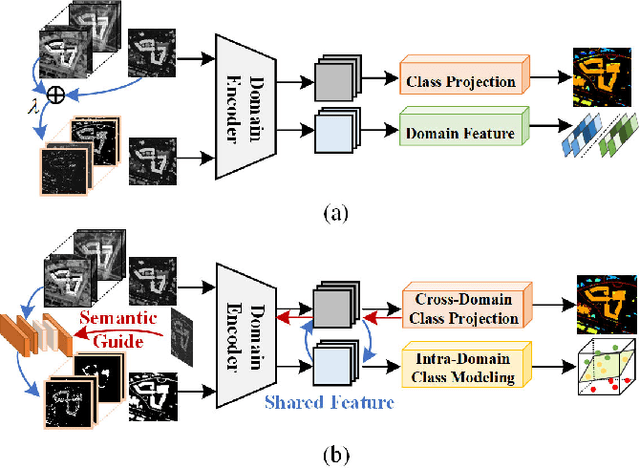
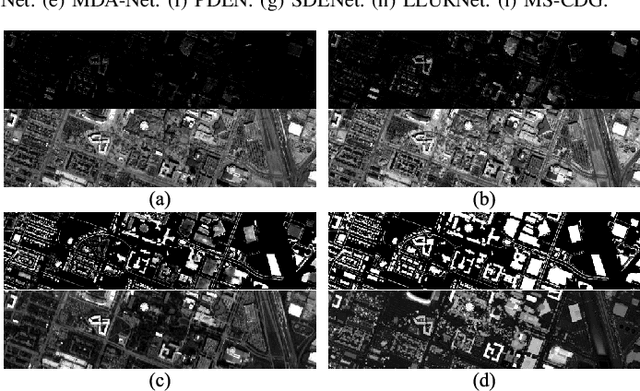

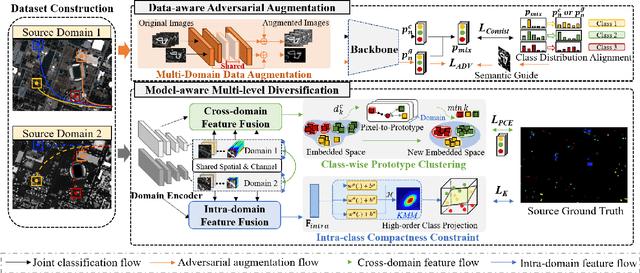
Abstract:Cross-scene image classification aims to transfer prior knowledge of ground materials to annotate regions with different distributions and reduce hand-crafted cost in the field of remote sensing. However, existing approaches focus on single-source domain generalization to unseen target domains, and are easily confused by large real-world domain shifts due to the limited training information and insufficient diversity modeling capacity. To address this gap, we propose a novel multi-source collaborative domain generalization framework (MS-CDG) based on homogeneity and heterogeneity characteristics of multi-source remote sensing data, which considers data-aware adversarial augmentation and model-aware multi-level diversification simultaneously to enhance cross-scene generalization performance. The data-aware adversarial augmentation adopts an adversary neural network with semantic guide to generate MS samples by adaptively learning realistic channel and distribution changes across domains. In views of cross-domain and intra-domain modeling, the model-aware diversification transforms the shared spatial-channel features of MS data into the class-wise prototype and kernel mixture module, to address domain discrepancies and cluster different classes effectively. Finally, the joint classification of original and augmented MS samples is employed by introducing a distribution consistency alignment to increase model diversity and ensure better domain-invariant representation learning. Extensive experiments on three public MS remote sensing datasets demonstrate the superior performance of the proposed method when benchmarked with the state-of-the-art methods.
Dual-Branch Subpixel-Guided Network for Hyperspectral Image Classification
Dec 05, 2024



Abstract:Deep learning (DL) has been widely applied into hyperspectral image (HSI) classification owing to its promising feature learning and representation capabilities. However, limited by the spatial resolution of sensors, existing DL-based classification approaches mainly focus on pixel-level spectral and spatial information extraction through complex network architecture design, while ignoring the existence of mixed pixels in actual scenarios. To tackle this difficulty, we propose a novel dual-branch subpixel-guided network for HSI classification, called DSNet, which automatically integrates subpixel information and convolutional class features by introducing a deep autoencoder unmixing architecture to enhance classification performance. DSNet is capable of fully considering physically nonlinear properties within subpixels and adaptively generating diagnostic abundances in an unsupervised manner to achieve more reliable decision boundaries for class label distributions. The subpixel fusion module is designed to ensure high-quality information fusion across pixel and subpixel features, further promoting stable joint classification. Experimental results on three benchmark datasets demonstrate the effectiveness and superiority of DSNet compared with state-of-the-art DL-based HSI classification approaches. The codes will be available at https://github.com/hanzhu97702/DSNet, contributing to the remote sensing community.
Quantum Information-Empowered Graph Neural Network for Hyperspectral Change Detection
Nov 12, 2024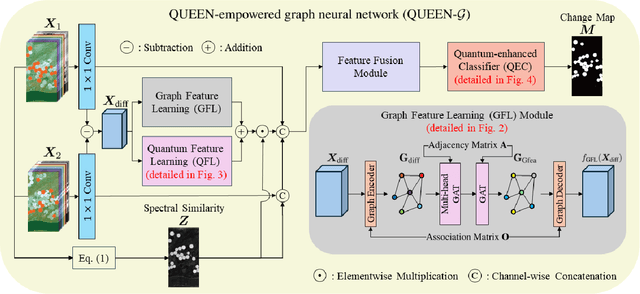



Abstract:Change detection (CD) is a critical remote sensing technique for identifying changes in the Earth's surface over time. The outstanding substance identifiability of hyperspectral images (HSIs) has significantly enhanced the detection accuracy, making hyperspectral change detection (HCD) an essential technology. The detection accuracy can be further upgraded by leveraging the graph structure of HSIs, motivating us to adopt the graph neural networks (GNNs) in solving HCD. For the first time, this work introduces quantum deep network (QUEEN) into HCD. Unlike GNN and CNN, both extracting the affine-computing features, QUEEN provides fundamentally different unitary-computing features. We demonstrate that through the unitary feature extraction procedure, QUEEN provides radically new information for deciding whether there is a change or not. Hierarchically, a graph feature learning (GFL) module exploits the graph structure of the bitemporal HSIs at the superpixel level, while a quantum feature learning (QFL) module learns the quantum features at the pixel level, as a complementary to GFL by preserving pixel-level detailed spatial information not retained in the superpixels. In the final classification stage, a quantum classifier is designed to cooperate with a traditional fully connected classifier. The superior HCD performance of the proposed QUEEN-empowered GNN (i.e., QUEEN-G) will be experimentally demonstrated on real hyperspectral datasets.
COSMo: CLIP Talks on Open-Set Multi-Target Domain Adaptation
Aug 31, 2024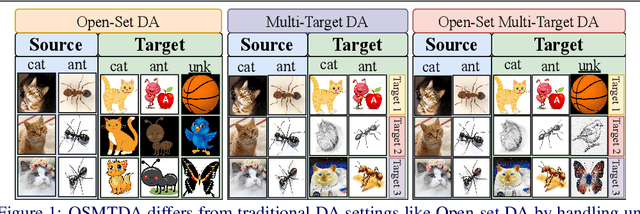

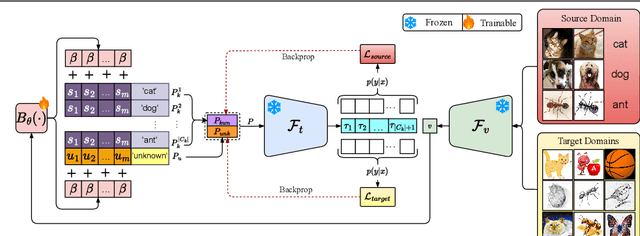

Abstract:Multi-Target Domain Adaptation (MTDA) entails learning domain-invariant information from a single source domain and applying it to multiple unlabeled target domains. Yet, existing MTDA methods predominantly focus on addressing domain shifts within visual features, often overlooking semantic features and struggling to handle unknown classes, resulting in what is known as Open-Set (OS) MTDA. While large-scale vision-language foundation models like CLIP show promise, their potential for MTDA remains largely unexplored. This paper introduces COSMo, a novel method that learns domain-agnostic prompts through source domain-guided prompt learning to tackle the MTDA problem in the prompt space. By leveraging a domain-specific bias network and separate prompts for known and unknown classes, COSMo effectively adapts across domain and class shifts. To the best of our knowledge, COSMo is the first method to address Open-Set Multi-Target DA (OSMTDA), offering a more realistic representation of real-world scenarios and addressing the challenges of both open-set and multi-target DA. COSMo demonstrates an average improvement of $5.1\%$ across three challenging datasets: Mini-DomainNet, Office-31, and Office-Home, compared to other related DA methods adapted to operate within the OSMTDA setting. Code is available at: https://github.com/munish30monga/COSMo
SpectralEarth: Training Hyperspectral Foundation Models at Scale
Aug 15, 2024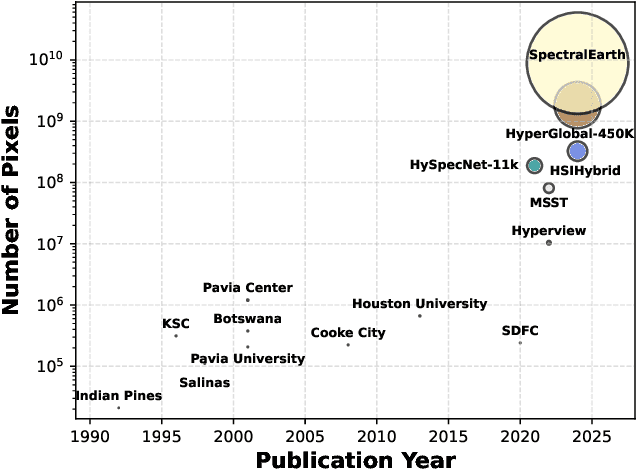
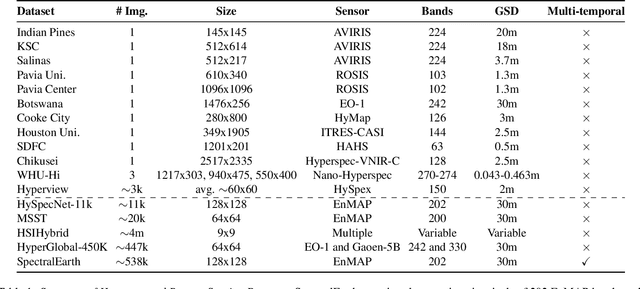

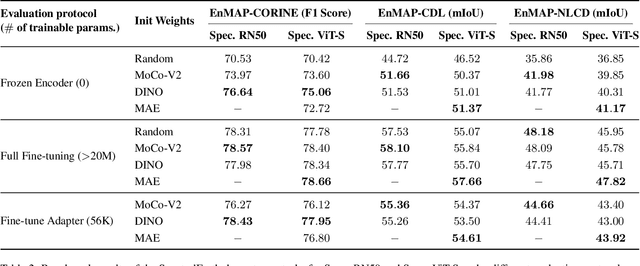
Abstract:Foundation models have triggered a paradigm shift in computer vision and are increasingly being adopted in remote sensing, particularly for multispectral imagery. Yet, their potential in hyperspectral imaging (HSI) remains untapped due to the absence of comprehensive and globally representative hyperspectral datasets. To close this gap, we introduce SpectralEarth, a large-scale multi-temporal dataset designed to pretrain hyperspectral foundation models leveraging data from the Environmental Mapping and Analysis Program (EnMAP). SpectralEarth comprises 538,974 image patches covering 415,153 unique locations from more than 11,636 globally distributed EnMAP scenes spanning two years of archive. Additionally, 17.5% of these locations include multiple timestamps, enabling multi-temporal HSI analysis. Utilizing state-of-the-art self-supervised learning (SSL) algorithms, we pretrain a series of foundation models on SpectralEarth. We integrate a spectral adapter into classical vision backbones to accommodate the unique characteristics of HSI. In tandem, we construct four downstream datasets for land-cover and crop-type mapping, providing benchmarks for model evaluation. Experimental results support the versatility of our models, showcasing their generalizability across different tasks and sensors. We also highlight computational efficiency during model fine-tuning. The dataset, models, and source code will be made publicly available.
 Add to Chrome
Add to Chrome Add to Firefox
Add to Firefox Add to Edge
Add to Edge